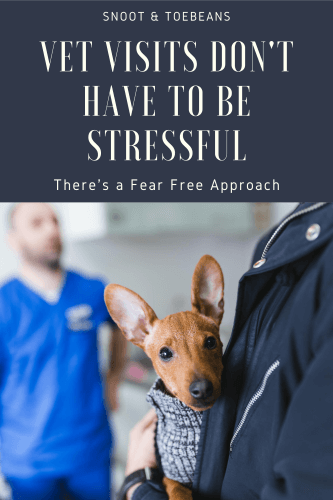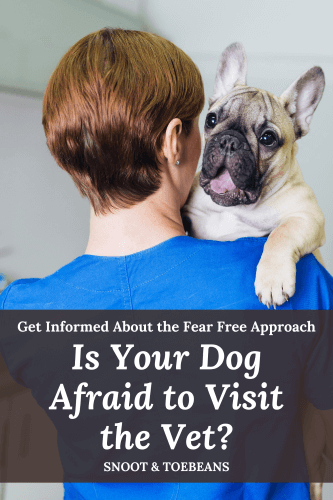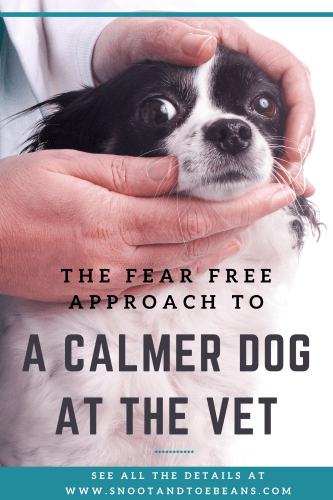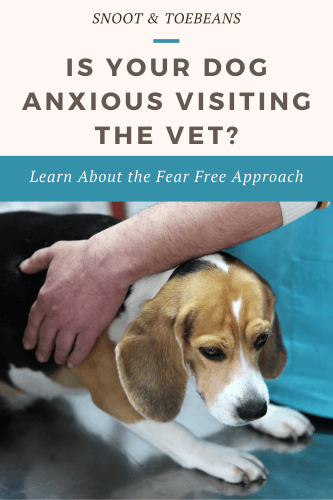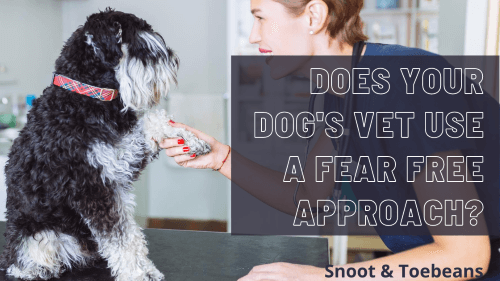Disclosure: My dog blog is supported by dog parents just like you. I only recommend products that I would use on my dogs. All opinions expressed here are my own. I sometimes earn a small affiliate commission, at no extra cost to you, when you click through the affiliate link and purchase something. You can read more about my affiliate policy here.
Do you have a dog who suffers from fear, anxiety, and stress (FAS)? Does a visit to the vet make you both a nervous wreck? Well, there is good news! More veterinarians are using a Fear Free approach to treat animals. To clarify, the emotional well-being of animals is now being recognized as important to good health.

Firstly, let’s talk about why it’s important that there is a Fear Free approach to treat animals. Many dogs suffer from FAS, so a trip to the veterinarian or pet groomer can be stressful. And, not just for your dog, but for you, too!
Furthermore, many dog parents think their dog will “outgrow” the subtle signs of emotional injury and turmoil. Therefore, this leads to unnecessary trauma and suffering.
FAS are the underlying cause of concerning behaviors such as:
- excessive barking
- aggression
- destructive behaviors
- house-soiling
- running away
- hiding
Some triggers that can set off FAS:
- veterinarian visits
- grooming visits
- loud noises such as, thunderstorms, fireworks, the vacuum cleaner, construction, gunshots, or even timers on appliances and alarm clocks
- car rides, long or short
- unfamiliar people or animals encountered on walks or near home
- being left alone during work hours or even for short errands
So, you can see the importance of veterinarians taking a Fear Free approach to treat dogs. This movement of veterinarians are working hard to create positive, low-stress office and hospital experiences. Therefore, these experiences reduce stress for dogs and their parents!
What is a Fear Free Approach?
A fear free approach in veterinary care actually goes back 30 or 40 years. Above all, the intention is to address both the emotional well-being and physical health of animals.
However, it was in 2016, that Dr. Marty Becker, trade named the approach as Fear Free®. In addition, Dr. Becker’s Fear Free® program certifies veterinarians and their practices in the Fear Free® approach.
The Fear Free slogan sums up it’s overall initiative, “taking the ‘pet’ out of ‘petrified’”. In addition, their mission is to prevent and alleviate fear, anxiety, and stress in pets. Fear Free is accomplishing this by inspiring and educating the people who care for pets.
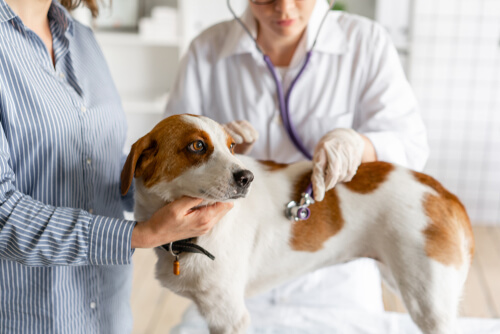
Therefore, Fear Free provides online and in-person education to veterinary professionals and the pet professional community. Furthermore, they even provide learning for pet parents.
The Fear Free approach is to use considerate and gentle control techniques in a calming environment. Therefore, these methods and protocols lead to the reduction or removal of FAS triggers mentioned above.
So, with FAS triggers reduced or removed, the experience becomes rewarding and safer for your dog. In addition, it will be easier for you to get your dog back for veterinary visits.
Fear Free® realizes that FAS leads to permanent changes in the brain. More specifically, the region of the amygdala is affected. The amygdala is thought to play important roles in emotion and behavior. Furthermore, it is best known for its role in the processing of fear.
So, a puppy’s first experiences with a veterinarian stays with it for life. Therefore, by engaging a Fear Free approach that reduces FAS, the cortex can override the amygdala.
The cortex plays a key role in attention, perception, awareness, thought, and memory. So, even an older dog can learn that the veterinarian is safe.
What Makes a Fear Free Approach Vet Visit Distinct?
Firstly, the waiting room area is different. There are species-specific areas. In addition, you can wait in your car with your dog until you are texted or called. Then, when texted or called, you and your dog are taken right into an exam room.
If you have chosen to wait inside, your dog will have a non-slip surface to stand on. This could be a yoga mat or a warm, pheromone-infused towel.
Furthermore, while waiting, your dog and even you will experience calming aromas from pheromone and aromatherapy diffusers. Also, pet-friendly music will be playing to have a calming effect on the central nervous system. And, this isn’t just for the waiting room.
Initially Fear Free® certified veterinary team members will focus only on you, avoiding eye contact with your dog. Therefore, your dog has time to check out the environment and become accustomed to the team member’s presence.
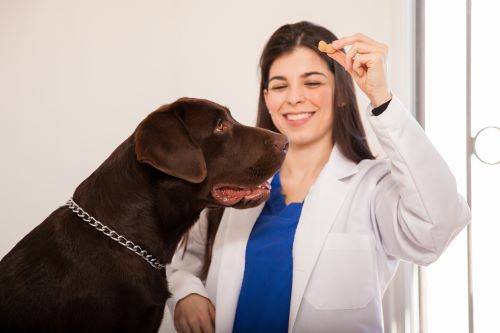
Another Fear Free technique is using small treats to welcome your dog. But, mostly treats are to distract your dog from procedures and reward for cooperation. So, you might want to take your dog hungry for the visit.
In addition to the treats, veterinary team members use other distraction techniques such as toys.
More Differences in a Fear Free Approach Vet Visit
Color therapy is another Fear Free approach to help keep your dog calm. You will notice veterinary team members wearing lab coats and scrubs in shades of pastel colors. Furthermore, research has shown that bright and white colors can be startling for dogs.
At a Fear Free® vet clinic, you will be with your dog at all times. Very rarely will a team member take your dog to the back to perform a procedure. Therefore, your dog will be reassured by your presence during exams and procedures.
When needed, a Fear Free® veterinarian will prescribe calming medication for the car ride to the vet. Furthermore, this can help make the visit more enjoyable and less frightening.
To make future visits even better, veterinary team members will note your dog’s emotional response to the visit. They will pay attention to what treats and techniques work best to reduce any FAS expressed.
Other Notations on Fear Free® Veterinary Practices
As mentioned above, Dr. Becker’s Fear Free® organization certifies veterinarians and their practices in the Fear Free® approach. Furthermore, the Fear Free® practices are taught globally and online to veterinary professionals and support teams.
These professionals have learned how to emotionally enrich and reduce FAS in pets. In addition, after completing several modules of specific continuing education courses, they become certified. These courses are accredited by the American Animal Hospital Association.
Veterinary practices have taken extra time to complete behavioral and Fear Free® training to help treat fearful pets. Since 2016, Fear Free® has trained more than 50,000 veterinary and pet professionals on pet emotional well-being.
Your dog’s emotional well-being is important, because it can have an impact on his or her physiological health. In other words, a veterinarian can’t accurately diagnose or monitor your dog’s health if FAS is present.
“Stress negatively influences physical parameters such as heart rate, respiratory rate, and temperature. In the stressed individual, these parameters, routinely checked with most veterinary visits, are not an accurate representation of the dog’s overall health. And stress suppresses the immune response.”
Kenneth Martin, DVM, DACVB, a co-owner of Veterinary Behavior Consultations, in Austin, Texas
Fear Free® Resources
Lucky for us dog parents, FearFreeHappyHomes.com launched in 2017. Consequently, this site features articles, courses, and other board-certified veterinary behaviorist-created content.
Furthermore, it provides us the tools to prevent and reduce FAS at home with our dog’s daily activities. Above all, it’s totally FREE!
“Making Fear Free Happy Homes resources free to pet owners will offer better access to the program. As veterinarians or pet professionals, we might see pets a few times a year, but their pet parents see them every day. Sharing simple, science-based approaches to helping pets have happier lives is core to our mission, and this change will remove barriers and ease stress for both pets and their humans.”
Marty Becker, DVM, CEO and founder of Fear Free and Veterinary Practice News columnist
When you sign up, you will have immediate, FREE access to the following:
- videos with fun, easy-to-implement tips
- articles reviewed by board-certified veterinary behaviorist
- discounts on pet products and services
- downloadable handouts with games, tips and tricks
- the Fear Free Certified® Professionals Directory to locate veterinary and pet professionals
In addition to FearFreeHappyHomes.com, dog parents can purchase From Fearful to Fear Free. This book was written by Dr. Becker and two more veterinarians and one pet trainer. Furthermore, it is the first and most authoritative book on the subject of reducing FAS. It’s based on the Fear Free® program founded by Dr. Becker.
To Sum Up
Whether a pet professional or parent, using a Fear Free approach puts the “happy and calm” in dogs. In addition, using the Fear Free® resources above will help you understand your dog’s nonverbal communication.
Furthermore, when you know your dog’s body language, you can take action to prevent FAS triggers. Or, you can take action to treat a FAS episode. Above all, if your dog suffers from FAS, I suggest you find a Fear Free® certified veterinary practice.
Speaking of anxiety, you might like this post, Dog Separation Anxiety – Put a Plan in Place.
Do you have a dog that suffers from FAS? We would love to hear about it in the comments below.
What about any FAS tips? Please help our readers by sharing them in the comments below.
Have you taken your dog to a Fear Free Certified® veterinary practice? We would love it if you would share your experience in the comments below.
Also, check out these posts:
If you want to save this post to your Pinterest account, you can pin one of the following images.
